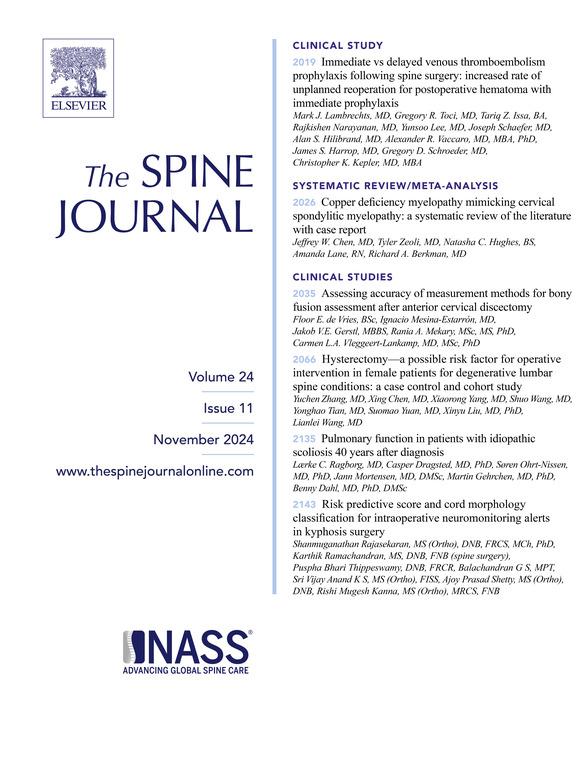Antiosteoporosis medication in patients with posterior spine fusion: a systematic review and meta-analysis
IF 4.7
1区 医学
Q1 CLINICAL NEUROLOGY
引用次数: 0
Abstract
Background Context
Osteoporosis and osteopenia are common among patients undergoing posterior spine fusion surgery, presenting challenges such as pseudarthrosis, screw loosening, and poor patient outcomes. While pharmacological interventions are available, no consensus exists regarding the optimal perioperative treatment for these patients. Furthermore, the effectiveness of various treatment options in improving fusion rates and minimizing complications remains uncertain.
Purpose
To compare the effects of teriparatide, bisphosphonates, denosumab, and romosozumab in patients with posterior spine fusion with low bone mineral density (BMD).
Study Design
Systematic review and meta-analysis.
Patient Sample
Adult patients with low BMD receiving osteoporosis medications and undergoing posterior spine fusion surgery.
Outcome Measures
Fusion rate, subsequent vertebral fracture (VF), screw loosening, cage subsidence, proximal junctional kyphosis (PJK), and patient-reported outcomes (PROs), particularly the Visual Analogue Scale (VAS) and Oswestry Disability Index (ODI).
Methods
A systematic search was conducted using PubMed, EMBASE, and Cochrane Library. Two reviewers independently selected and assessed relevant studies. Four groups were analyzed to evaluate the comparative effectiveness of antiosteoporosis medication on the outcome measures: Bisphosphonate versus Control; Teriparatide versus Control; Teriparatide versus Bisphosphonate; and Denosumab versus Control.
Results
Bisphosphonate showed reduced subsequent VFs (odds ratio [OR]=0.27, 95% confidence interval [CI]=0.09–0.81) and cage subsidence (OR=0.29, 95% CI=0.11–0.75) and improved ODI scores at 12 months (standardized mean difference [SMD] [95% CI]=-0.75 [-1.42, -0.08]) compared to the control. Teriparatide showed a higher fusion rate (OR=3.52, 95% CI=1.84–6.75), lower screw loosening (OR=0.23, 95% CI=0.09–0.60), and improved ODI scores at 24 months (SMD [95% CI]=-0.57 [-0.99, -0.15]) compared to the control. Moreover, teriparatide showed a higher fusion rate (OR=2.28, 95% CI=1.67–3.11), lower subsequent VF (OR=0.22, 95% CI=0.09–0.51), and improved VAS score for back pain (VASB) (mean difference [MD] [95% CI]=-0.30 [-0.54, -0.07]) and ODI (SMD [95% CI]=-0.38[-0.64, -0.12]) scores at 12 months compared to bisphosphonate. Denosumab showed no significant difference in fusion rate or other complications compared to control.
Conclusion
Our results indicated that teriparatide should be used as the first-line perioperative treatment for patients with poor bone quality scheduled for posterior spine fusion. Teriparatide exhibited better fusion rates and reduced complications than controls and bisphosphonates, resulting in improved PROs. Moreover, bisphosphonates can be utilized in patients with contraindications to teriparatide since the former prevents osteoporosis-related complications compared to controls, resulting in improved PROs. Further studies are warranted to evaluate the potential effects of denosumab and romosozumab.
后路脊柱融合术患者的抗骨质疏松药物治疗:一项系统回顾和荟萃分析。
背景:骨质疏松和骨质减少在后路脊柱融合术患者中很常见,这给假关节、螺钉松动和患者预后差等患者带来了挑战。虽然药物干预是可用的,但对于这些患者的最佳围手术期治疗尚无共识。此外,各种治疗方案在提高融合率和减少并发症方面的有效性仍不确定。目的:比较特立帕肽、双膦酸盐、地诺单抗和罗莫索单抗在低骨密度(BMD)后路脊柱融合患者中的疗效。研究设计:系统评价和meta分析患者样本:接受骨质疏松药物治疗并接受后路脊柱融合术的低骨密度成年患者。结果测量:融合率、随后的椎体骨折(VF)、螺钉松动、cage下沉、近端连接处后凸和患者报告的结果(PROs),特别是视觉模拟评分(VAS)和Oswestry残疾指数(ODI)。方法:系统检索PubMed、EMBASE和Cochrane图书馆。两名审稿人独立选择和评估相关研究。对四组进行分析,以评估抗骨质疏松药物对结局指标的比较有效性:双膦酸盐与对照组;特立帕肽与对照组;特立帕肽vs双膦酸盐;Denosumab与Control。结果:与对照组相比,双膦酸盐降低了后续VFs[比值比(OR)=0.27, 95%可信区间(CI)=0.09-0.81]和笼沉降[OR=0.29, 95% CI=0.11-0.75],并改善了12个月时的ODI评分[标准化平均差(SMD) (95% CI)=-0.75(-1.42, -0.08)]。与对照组相比,特利帕肽显示更高的融合率[OR=3.52, 95% CI=1.84-6.75],更低的螺钉松动[OR=0.23, 95% CI=0.09-0.60],并且在24个月时改善ODI评分[SMD (95% CI)=-0.67(-1.23, -0.11)]。此外,与双膦酸盐相比,特利帕肽显示更高的融合率[OR=2.13, 95% CI=1.55-2.93],更低的后续VF [OR=0.22, 95% CI=0.09-0.51],并改善了12个月时腰痛VAS评分(VASB)[平均差值(MD) (95% CI)=-0.39(-0.64, -0.13)]和ODI [SMD (95% CI)=-0.39(-0.65, -0.13)]评分。与对照组相比,Denosumab在融合率和其他并发症方面没有显着差异。结论:我们的研究结果表明,特立帕肽应作为围手术期治疗骨质量差的患者后路脊柱融合术的一线治疗。特立帕肽表现出比对照组和双膦酸盐更好的融合率和更少的并发症,从而改善了PROs。此外,与对照组相比,双膦酸盐可用于特里帕肽禁忌症患者,因为前者可预防骨质疏松相关并发症,从而改善PROs。需要进一步的研究来评估denosumab和romosozumab的潜在作用。
本文章由计算机程序翻译,如有差异,请以英文原文为准。
求助全文
约1分钟内获得全文
求助全文
来源期刊

Spine Journal
医学-临床神经学
CiteScore
8.20
自引率
6.70%
发文量
680
审稿时长
13.1 weeks
期刊介绍:
The Spine Journal, the official journal of the North American Spine Society, is an international and multidisciplinary journal that publishes original, peer-reviewed articles on research and treatment related to the spine and spine care, including basic science and clinical investigations. It is a condition of publication that manuscripts submitted to The Spine Journal have not been published, and will not be simultaneously submitted or published elsewhere. The Spine Journal also publishes major reviews of specific topics by acknowledged authorities, technical notes, teaching editorials, and other special features, Letters to the Editor-in-Chief are encouraged.
 求助内容:
求助内容: 应助结果提醒方式:
应助结果提醒方式:


